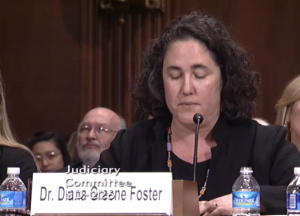Last week the Senate Judiciary Committee, chaired by Chuck Grassley (R-IA), held a pro-life hearing titled “Late-Term Abortion: Protecting Babies Born Alive and Capable of Feeling Pain.” The
While members of the Republican majority presented witnesses in favor of a 20-week ban on abortions due to the child’s ability to feel pain, members of the Democratic minority presented witnesses that were opposed to this idea and, even, opposed to caring for children born alive after failed abortion attempts.
Perched at the head of the minority party was Sen. Dianne Feinstein (D-CA). Feinstein proposed the stale line that an abortion ban of any sort would send women to “coat hangers” to obtain abortions. And her opposition to 20-week abortion bans was padded by saying, “Twenty-week legislation has failed already.”
Therefore, Feinstein insisted:
I believe this is a sustained political effort to make it as hard as possible for women to access healthcare which should be safe and legal.
Feinstein said that if a 20-week bill passes, women will be “driven underground” and as a result, “women will be injured.” The twenty-week bill is a step backwards,” she said.
 Feinstein and her pro-abortion stance are nothing new in the state of California, and the San Francisco native shares ideology with a San Francisco professor who testified in the same hearing. Minority witness, Diana Greene Foster, PhD (pictured), is a professor in the Department of Obstetrics, Gynecology and Reproductive Sciences at the University of California, San Francisco. She’s part of the infamous Bixby Center for Global Reproductive Health, which is a leader in “family planning” fellowships. UCSF’s Fellowship in Family Planning is, in essence, abortion training:
Feinstein and her pro-abortion stance are nothing new in the state of California, and the San Francisco native shares ideology with a San Francisco professor who testified in the same hearing. Minority witness, Diana Greene Foster, PhD (pictured), is a professor in the Department of Obstetrics, Gynecology and Reproductive Sciences at the University of California, San Francisco. She’s part of the infamous Bixby Center for Global Reproductive Health, which is a leader in “family planning” fellowships. UCSF’s Fellowship in Family Planning is, in essence, abortion training:
The Fellowship in Family Planning is a two-year fellowship focused on subspecialist training in research, teaching and clinical practice in abortion and contraception.
Thus, it’s no surprise that Foster would vehemently defend late-term abortion, as well as allowing babies born alive to be left to die. She claimed a 20-week abortion ban “will adversely affect the lives of women and their children across the country.”
Foster’s ensuing reasons for not banning abortion after 20 weeks were detailed, but illogical. She began her testimony by saying, “It is important to understand that nearly one in three American women has an abortion in her lifetime. Later abortions, those at or after 20 weeks, are rare, comprising less than 2% of abortions performed in the United States. However, women are increasingly unable to get the abortions they seek.”
It seems that because one in three women have had an abortion, that is her reasoning for making it available. Included in her reasons are further fallacies of logic. She says:
And we find that women who must carry unwanted pregnancies to term are more likely to live in poverty three years later than women who were able to receive an abortion. They are more likely to receive public assistance and less likely to have full time jobs. They are less likely to have aspirational life plans, like getting a better job or finishing school, and six times less likely than women who receive an abortion to achieve an aspirational plan in the year after being turned away.
Another common reason women in our study cited for wanting to terminate a pregnancy was their concern about being able to care for the children they already have.
Her list continues, but none actually addresses the fact that a woman has the option of placing her child with an adoptive family. While a woman not able to financially care for a child might live in poverty, she also can choose to place her child for adoption so she doesn’t have to take a life but also doesn’t have to provide for that child when she does not feel financially or emotionally ready. This either/or fallacy of logic implies that “either abortion is allowed anytime a woman wants one or her lifestyle will be significantly diminished.” This is just that: a fallacy.
Sen. Lindsey Graham (R-SC) asked one of the majority witnesses, Dr. Colleen A. Malloy, Assistant Professor of Pediatrics-Neonatology at Northwestern University Feinberg School of Medicine, if it would be standard practice in neonatal surgery to give a 20 or 22-week-old baby anesthesia. Malloy testified that in neonatal and fetal surgery the baby would be administered anesthesia “because they can feel pain.”
With that established, Sen. Graham returned to Foster to note that only seven nations in the world allow abortions past 20 weeks, the United States among them. Foster then launched into the tragedy of women seeking back-door abortions in nations other than these seven, and how it affected them. Sen. Graham asked for evidence on the effects of nations not offering abortions at will, but Foster could offer none other than to say that maternal mortality rates might increase or women might seek illegal abortions.

Famous Nilsson photo of a preborn baby at 20 weeks
As Sen. David Vitter (R-LA) asked Foster if she believed that there are cases where medical care should not be provided to a baby born alive, she responded:
I can imagine a situation where the doctors and nurses have decided that there’s not a point in medical intervention and by whisking the baby away[for medical care], you’ve taken away a woman’s chance to hold her child and say goodbye.
It’s tragically ironic to say a woman who has just paid to kill her potentially viable child should then be allowed to say goodbye rather than to let someone save the child. To Foster, that’s the point, because by forcing the medical practitioners to take the baby for medical care, it removes the rights of the patient to decide medical care might not work anyway. Thus, she should be able to say goodbye.
Foster seemed to miss the idea that a woman who has just had an abortion probably isn’t an expert who should decide if medical care could work or not. All that matters to Foster is that every choice belongs to the woman, and therefore, any baby unintentionally born alive should not be taken for medical care.
She also said, “The problem with this bill is that it treats all pregnancies the same.” For the purposes she notes, they are the same. They are babies with a right to life.
In her initial testimony, Foster concluded:
As a researcher, I believe that any law restricting the provision of medical care should take into account its effect on women’s health and wellbeing as determined by sound empirical research, especially laws restricting a medical procedure that nearly one in three American women experience. In this case, the evidence indicates that a nationwide 20-week ban on abortion will adversely affect the lives of women and their children across the country.
The problem with Foster’s “sound empirical research” is that it is just that, empirical, which means “experience.” While Foster may have interviewed many women over a multi-year period, all of the research she cites is experiential from the viewpoint of what women who have an abortion want.  Empirical research is a wonderful thing for studying people in their natural habitats and discovering societal patterns – thus, the opinions and experiences of post-abortive women who support abortion rights are valid within that community. But none of Foster’s research actually shows what scientific research says. To extend Foster’s findings to argue against physicians and medical research shows a lack of understanding of research applications.
Empirical research is a wonderful thing for studying people in their natural habitats and discovering societal patterns – thus, the opinions and experiences of post-abortive women who support abortion rights are valid within that community. But none of Foster’s research actually shows what scientific research says. To extend Foster’s findings to argue against physicians and medical research shows a lack of understanding of research applications.
What doesn’t Foster’s research show? That babies are born alive and are left to suffer and die, or that a baby feels pain at 20 weeks, as medical experts have testified. In the light of these facts, arguments about coat hangers and common abortions ring hollow.








